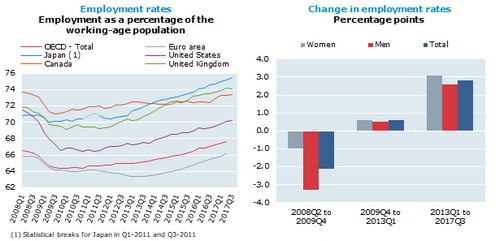OECD employment rate increases to 67.8% in the third quarter of 2017
The OECD area employment rate – the share of working-age people in jobs – increased by 0.2 percentage point in the third quarter of 2017, to 67.8% and is now 3.4 percentage points above the trough observed in the fourth quarter of 2009. Across the OECD area, around 561 million people were employed in the third quarter of 2017.

Compared with the second quarter of 2017, the euro area employment rate rose by 0.2 percentage point (to 66.4%), with the highest gains observed in Estonia (up 1.2 percentage point, to 74.2%), Latvia (up 0.8 percentage point, to 70.5%), Portugal (up 0.8 percentage point, to 68.2%), Luxembourg (up 0.7 percentage point, to 66.9%), and Slovenia (up 0.7 percentage point, to 69.5%). By contrast, the employment rate fell, by 0.2 percentage point, in Austria (to 71.9%) and France (to 64.6%).
Outside the euro area, the largest increases were observed in New Zealand (up 0.8 percentage point, to 77.1%), Turkey (up 0.7 percentage point, to 51.8%) and the Czech Republic (up 0.6 percentage point, to 74.0%). The employment rate also increased in Japan (by 0.3 percentage point, to 75.5%) and by 0.1 percentage point in Canada (to 73.4%) and the United States (to 70.2%), while it decreased by 0.1 percentage point in Mexico (to 61.0%) and the United Kingdom (to 74.1%).
Gains in the employment rate for women (up 0.3 percentage point in the third quarter of 2017) exceeded those recorded for men (up 0.1 percentage point), narrowing the gap between the two to 15.3 percentage points. The gap is now 2.9 percentage points smaller than in the second quarter of 2008, reflecting a stronger decline in the employment rate of men during the crisis and a slightly faster recovery in the employment rate of women since then.
Source: Organization for Economic Co-operation and Development
- 338 reads
Human Rights
Fostering a More Humane World: The 28th Eurasian Economic Summi

Conscience, Hope, and Action: Keys to Global Peace and Sustainability

Ringing FOWPAL’s Peace Bell for the World:Nobel Peace Prize Laureates’ Visions and Actions

Protecting the World’s Cultural Diversity for a Sustainable Future

Puppet Show I International Friendship Day 2020

